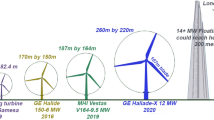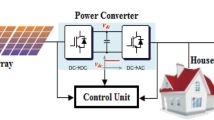Abstract
Aiming at the problem of global climate change and energy crisis, wind power has become the focus of energy sustainable development in all countries. The wind turbines (WTs) power system is connected to the grid via the power electronic converter, causing the system inertia level to drop. In this paper, the direct-drive WT system is considered as the research object, and the whole-system frequency response model is established. The inertia and damping characteristics of the WT converter systems with virtual inertia control are analyzed. With the support of fan rotor kinetic energy and the energy saved in a capacitor, the simple control can also make the system exhibit different degrees of inertia and damping features. The results show that the equivalent inertia and the WT inertia time constant, capacitance parameters and virtual control parameters kd are related; the equivalent damping parameter is related to the steady-state operating point parameters and the virtual control parameter kp; the equivalent synchronization parameter is related to the steady-state operating point parameters and the virtual inertia control parameter ki. Finally, the correctness of the inertial and damping characteristics of the WT grid-connected system is verified by simulation, which provides a theoretical reference for studying the inertial damping of power electronic dominant systems.










Similar content being viewed by others
References
Arani MFM, El-Saadany EF (2013) Implementing virtual inertia in DFIG-based wind power generation. IEEE Trans Power Syst 28:1373–1384
Blaabjerg F, Teodorescu R, Liserre M, Timbus AV (2006) Overview of control and grid synchronization for distributed power generation systems. IEEE Trans Ind Electron 53:1398–1409
Carrasco JM, Franquelo LG, Bialasiewicz JT, Galvan E, Guisado RCP, Prats MAM, Leon JI, Moreno-Alfonso N (2006) Power electronic systems for the grid integration of renewable energy sources: a survey. IEEE Trans Ind Electron 53:1002–1016
Chang X, Yang Y (2017) Semisupervised feature analysis by mining correlations among multiple tasks. IEEE Trans Neural Netw Learn Syst 28(10):2294–2305
Chang X, Ma Z, Yang Y, Zeng Z, Hauptmann AG (2017a) Bi-level semantic representation analysis for multimedia event detection. IEEE Trans Cybern 47(5):1180–1197
Chang X, Yu YL, Yang Y, Xing EP (2017b) Semantic pooling for complex event analysis in untrimmed videos. IEEE Tran Pattern Anal Mach Intell 39(8):1617–1632
Conroy JF, Watson R (2008) Frequency response capability of full converter wind turbine generators in comparison to conventional generation. IEEE Trans Power Syst 23:649–656
Delille G, Francois B, Malarange G (2012) Dynamic frequency control support by energy storage to reduce the impact of wind and solar generation on isolated power system’s inertia. IEEE Trans Sustain Energy 3:931–939
Fang J, Li H, Tang Y, Blaabjerg F (2018a) On the inertia of future more-electronics power systems. IEEE Trans Power Electron 34:5416–5438
Fang J, Li H, Tang Y, Blaabjerg F (2018b) Distributed power system virtual inertia implemented by grid-connected power converters. IEEE Trans Power Electron 33:8488–8499
Fang J, Tang Y, Li H, Li X (2018c) A battery/ultracapacitor hybrid energy storage system for implementing the power management of virtual synchronous generators. IEEE Trans Power Syst 33:2820–2824
Gautam D, Goel L, Ayyanar R, Vittal V, Harbour T (2011) Control strategy to mitigate the impact of reduced inertia due to doubly fed induction generators on large power systems. IEEE Trans Power Syst 26:214–224
He W, Yuan X, Hu J (2017) Inertia provision and estimation of PLL-based DFIG wind turbines. IEEE Trans Power Syst 32:510–521
Hu J, Sun L, Yuan X, Wang S, Chi Y (2017) Modeling of type 3 wind turbine with df/dt inertia control for system frequency response study. IEEE Trans Power Syst 32(4):2799–2809
Ma J, Qiu Y, Li Y, Zhang W, Song Z, Thorp JS (2017) Research on the impact of DFIG virtual inertia control on power system small-signal stability considering the phase-locked loop. IEEE Trans Power Syst 32:2094–2105
Mauricioj M, Marano A, Gomez-Exposito A (2009) Frequency regulation contribution through variable speed wind energy conversion systems. IEEE Trans Power Syst 24:173–180
Ping-Kwan K, Pei L, Banakar H, Ooi BT (2009) Kinetic energy of wind-turbine generators for system frequency support. IEEE Trans Power Syst 24:279–287
Tan S, Geng H, Yang G (2018) Phillips-Heffron model for current-controlled power electronic generation unit. J Mod Power Syst Clean Energy 6:582–594
Wu Y, Zhang D, Xiong L, Wang S, Xu Z, Zhang Y (1985) Modeling and mechanism investigation of inertia and damping issues for grid-tied PV generation systems with droop control. Energies 2019:12
Xiong L, Zhuo F, Wang F, Liu X, Chen Y, Zhu M (2016) Static synchronous generator model: a new perspective to investigate dynamic characteristics and stability issues of grid-tied PWM inverter. IEEE Trans Power Electron 31:6264–6280
Xiu L, Xiong L, Yang P et al (2018) Inertial and damping characteristics of DC distributed power systems based on frequency droop control. Energies 11:2418
Ying J, Yuan X, Hu J, He W (2018) Impact of inertia control of DFIG-based WTS on electromechanical oscillation damping of SG. IEEE Trans Power Syst 33:3450–3459
Zhao M, Yuan X, Hu J (2018a) Modeling of DFIG wind turbine based on internal voltage motion equation in power systems phase-amplitude dynamics analysis. IEEE Trans Power Syst 33:1484–1495
Zhao M, Yuan X, Hu J (2018b) Modeling of DFIG wind turbine based on internal voltage motion equation in power systems phase-amplitude dynamics analysis. IEEE Trans Power Syst 33(2):1484–1495
Funding
This research was funded by National Natural Science Foundation of China (51977072); Natural Science Foundation of China (2018YFB0606005), National Natural Science Foundation of China (51870068), Hunan Provincial Natural Science Foundation Project (2017JJ4024) and Hunan Provincial Natural Science Foundation (2018JJ3129).
Author information
Authors and Affiliations
Corresponding author
Additional information
Communicated by V. Loia.
Publisher's Note
Springer Nature remains neutral with regard to jurisdictional claims in published maps and institutional affiliations.
Appendix
Appendix
Figure 4 shows a schematic diagram of the charging and discharging of a DC bus capacitor. The idc, ic, is and udc in the figure are the input current, capacitor current, output current and capacitor voltage, respectively.
According to the charging and discharging rules of the capacitor, we can get:
Selecting the reference voltage as the DC bus voltage Udc and the power selection system-rated capacity SB, the reference current IB can be obtained as:
Rewrite the current ic in equation (22) as (where Ek is the energy stored by the capacitor):
Combining equation (22) and dividing both sides of the equation by the current reference, we get:
Referring to the definition of the inertia time constant of the power system, the inertia time constant of the capacitor can be defined as:
This style (22) can be rewritten as:
In order to facilitate the analysis, the formula (27) is rewritten into the power expression as:
Under the control of the voltage outer loop, the udc change is small. It can be considered to be approximately 1.
The vector diagram of grid-connected current control using grid voltage orientation is shown in Fig. 11. According to the figure, the grid-connected current expression can be obtained (ignoring the filter capacitor current component):
When considering the effect of voltage control, we can get from equation (30):
Linearizing equation (10) near the steady-state operating point can obtain:
In the formula, K is a system structure parameter, and K = Us / cosδ0.
When the input power change is not considered, that is, δidc = 0, linearize equation (29), consider \( s\Delta \delta = \Delta \omega \) and consider equation (32) to eliminate δudc, and a dynamic model of the DC capacitor of the grid-connected inverter under the time scale of the DC voltage for:
and:
Referring to the definition of the kinetic energy analysis of the power system, the electric field energy stored by the capacitor can also provide certain inertia characteristics for the system. The electric field energy change is:
Then, the amount of change in the output electromagnetic power of the capacitor at time t is:
Combine the equivalent inertia time constant of the (34) capacitor link and consider equations (35) and (22) to obtain the inertia support power of the capacitor when the grid frequency changes:
Rights and permissions
About this article
Cite this article
Li, S., Donghui, Z., Lan, Z. et al. Modeling and mechanism analysis of inertia and damping issues for wind turbines PMSG grid-connected system. Soft Comput 24, 15681–15691 (2020). https://doi.org/10.1007/s00500-020-04897-6
Published:
Issue Date:
DOI: https://doi.org/10.1007/s00500-020-04897-6





